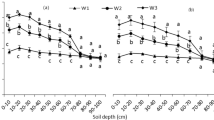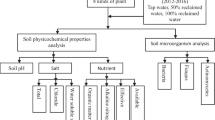Abstract
Partial root-zone irrigation creates a dynamic heterogeneous distribution of soil moisture that may affect the numbers and activities of soil microorganisms. In this study, three irrigation methods, i.e. conventional irrigation (CI), alternate partial root-zone irrigation (APRI, alternate watering on both sides of the pot) and fixed partial root-zone irrigation (FPRI, fixed watering on one side of the pot), and three watering levels, i.e. well-watered, mild and severe water deficit, were applied on pot-grown maize. Numbers of soil microorganisms, plant height, stalk diameter, leaf area and biomass accumulation were monitored over the treatment period. A quadratic parabola relationship between the number of soil microorganisms and soil water content was found, indicating the number of soil microorganisms reached a peak at the mild soil water deficit condition, possibly due to better soil aeration. The peak number of soil microorganism was obtained when soil water content was 66, 79 and 75% of field capacity for CI, FPRI and APRI, respectively. Soil microorganisms were evenly distributed in both sides of APRI and their total numbers were always higher than those under other two irrigation methods for the same soil water content. The count of soil microorganisms in the dry root zone of FPRI was reduced by a lack of water. Maximum biomass accumulation was obtained under well watered condition but severe water deficit led to a 50% reduction in the CI treatment. Such reduction was much smaller under APRI and therefore the highest water use efficiency was obtained. Our results suggest that APRI maintained the best aeration and moisture condition in the soil and enhanced the activities of soil microorganisms, which might also have benefited the plant growth.




Similar content being viewed by others
References
Bååth E, Anderson TH (2003) Comparison of soil fungal/bacterial ratios in a pH gradient using physiological and PLFA-based techniques. Soil Biol Biochem 35:955–963
Burger M, Jackson LE, Lundquist EJ, Louie DT, Miller RL, Rolston DE, Scow KM (2005) Microbial responses and nitrous oxide emissions during wetting and drying of organically and conventionally managed soil under tomatoes. Biol Fert Soil 42:109–118
Cheng L, Xue Q (2000) The experimentation of microbiology. World Book Press, Xi’an, pp. 80–83
Clein JS, Schmel JP (1994) Reduction in microbial activity in birch litter due to drying and rewetting events. Soil Biol Biochem 26:403–406
Davies WJ, Bacon MA, Thompson DS (2000) Regulation of leaf and fruit growth in plants growing in drying soil: exploitation of the plants’ chemical signaling system and hydraulic architecture to increase the efficiency of water use in agriculture. J Exp Bot 51:1617–1626
Drenovsky RE, Graham KJ, Scow KM (2004) Soil water content and organic carbon availability are major determinants of soil microbial community composition. Microbial Ecol 48:424–430
Dry PR, Loveys BR (1998) Factors influencing grapevine vigour and the potential for control with partial rootzone drying. Aust J Grape Wine Res 4:140–148
Du T, Kang S, Hu X, Yang X (2005) Effect of alternate partial root-zone drip irrigation on yield and water use efficiency of cotton. Sci Agri Sinica 38:2061–2068
Gu F, Wen Q, Pan B, Yang Y (2000) A preliminary study on soil microorganisms of artificial vegetation in the center of Taklimakan Dessert. Chin Biodiv 8:297–303
Hill GT, Mitkowski NA, Aldrich-Wolfe L, Emele LR, Jurkonie DD, Ficke A, Maldonado-Ramirez S, Lynch ST, Nelsona EB (2000) Methods for assessing the composition and diversity of soil microbial communities. Appl Soil Ecol 15:25–36
Kang S, Zhang J (2004) Controlled alternate partial root-zone irrigation: its physiological consequences and impact on water use efficiency. J Exp Bot 55:2437–2446
Kang S, Zhang J, Liang Z, Hu X, Cai H (1997) Controlled alternate partial rootzone irrigation: a new approach for water saving regulation in farmland. Agri Res Arid Areas 15:1–6
Kang S, Liang Z, Hu W, Zhang J (1998) Water use efficiency of controlled root-divided alternate irrigation. Agric. Water Manag 38:69–77
Kang S, Liang Z, Pan Y, Shi P, Zhang J (2000) Alternate furrow irrigation for maize production in an arid area. Agric Water Manag 45:267–274
Kang S, Zhang L, Hu X, Li Z, Jerie P (2001) An improve water use efficiency for hot pepper grown under controlled alternate drip irrigation on partial roots. Sci Hortic 89:257–267
Kang S, Hu X, Goodwin I, Jerie P (2002) Soil water distribution, water use, and yield of response to partial root zone drying under a shallow groundwater table condition in a pear orchard. Sci Hortic 92:277–291
Kang S, Hu X, Jerie P, Zhang J (2003) The effects of partial rootzone drying on root, trunk sap flow and water balance in an irrigated pear (Pyrus communis L.) orchard. J Hydrol 280:192–206
Linn DM, Doran JW (1984) Effect of water-filled pore space on carbon dioxide and nitrous oxide production in tilled and nontilled soils. Soil Sci Soc Am J 48:1267–1272
Lundquist EJ, Scow KM, Jackson LE, Uesugi SL, Johnson CR (1999) Rapid response of soil microbial communities from conventional, low input, and organic farming systems to a wet/dry cycle. Soil Biol Biochem 31:1661–1675
Rietz N, Haynes RJ (2003) Effects of irrigation-induced salinity and sodality on soil microbial activity. Soil Biol Biochem 35:845–854
Skinner RH, Hanson JD, Benjamin JG (1999) Nitrogen uptake and partitioning under alternate- and every-furrow irrigation. Plant Soil 210:11–20
Stromberger M, Shah Z, Westfall D (2007) Soil microbial communities of no-till dryland agroecosystems across an evapotranspiration gradient. Appl Soil Ecol 35:94–106
Vieira FCS, Nahas E (2005) Comparison of microbial numbers in soils by using various culture media and temperatures. Microbiol Res 160:197–202
Williams MA, Rice CW (2006) Seven years of enhanced water availability influences the physiological, structural, and functional attributes of a soil microbial community. Appl Soil Ecol 35:535–545
Wilson JM, Griffin DM (1974) Water potential and the respiration of microorganisms in the soil. Soil Biol Biochem 7:199–204
Zegbe-Domínguez JA, Beehboudian MH, Lang A, Clothier BE (2003) Deficit irrigation and partial rootzone drying maintain fruit dry mass and enhance fruit quality in ‘Petopride’ processing tomato. Sci Hortic 98:505–510
Acknowledgements
We are grateful to the research grants from Chinese National Natural Science Fund (2006CB403406, 50339030), Ministry of Education of the People’s Republic of China Fund (IRT0657), Hong Kong Research Grant Council (HKBU 2465/05M) and Hong Kong University Grants Committee (AoE/B-07/99).
Author information
Authors and Affiliations
Corresponding authors
Additional information
Responsible Editor: Rana E. Munns
Rights and permissions
About this article
Cite this article
Wang, J., Kang, S., Li, F. et al. Effects of alternate partial root-zone irrigation on soil microorganism and maize growth. Plant Soil 302, 45–52 (2008). https://doi.org/10.1007/s11104-007-9453-8
Received:
Accepted:
Published:
Issue Date:
DOI: https://doi.org/10.1007/s11104-007-9453-8




